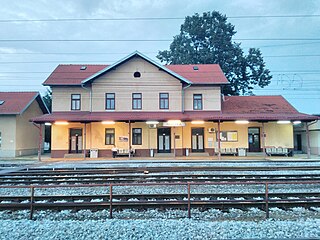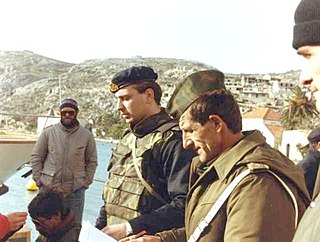Related Research Articles
Branimir Glavaš is a Croatian retired major general and politician. He was one of the founders of the Croatian Democratic Union (HDZ) party which was in power in the 1990s and one of its key figures until a split in 2006.

Novska is a town in the Sisak-Moslavina County of Croatia. It is located in western part of the historic region of Slavonia, between Kutina and Nova Gradiška, 94 km (58 mi) linear distance southeast of the capital, Zagreb.
The Battle of Borovo Selo of 2 May 1991, known in Croatia as the Borovo Selo massacre and in Serbia as the Borovo Selo incident, was one of the first armed clashes in the conflict which became known as the Croatian War of Independence. The clash was precipitated by months of rising ethnic tensions, violence, and armed combat in Pakrac and at the Plitvice Lakes in March. The immediate cause for the confrontation in the heavily ethnic Serb village of Borovo Selo, just north of Vukovar, was a failed attempt to replace the Yugoslav flag in the village with the flag of Croatia. The unauthorised effort by four Croatian policemen resulted in the capture of two by a Croatian Serb militia in the village. To retrieve the captives, the Croatian authorities deployed additional police, who drove into an ambush. Twelve Croatian policemen and one Serb paramilitary were killed before the Yugoslav People's Army (JNA) intervened and put an end to the clashes.
The Lora prison camp was a prison camp in Split, Croatia. It was active from 1992 to 1997 with mainly Serbian residents of Split and prisoners of war being imprisoned throughout the Croatian War of Independence. The camp was the site of human rights abuses resulting in a controversial trial, acquittal, retrial and conviction of prison guards.
Operation Swath-10 was a military offensive undertaken by the Croatian Army against the SAO Western Slavonia Territorial Defense Forces on Bilogora Mountain in western Slavonia. Occurring from 31 October to 4 November 1991, during the Croatian War of Independence, the operation was a Croatian victory and its success set the stage for follow-up advances by Croatian forces on Papuk Mountain in Operation Papuk-91 in late November and December. By the end of the year the HV gained control of Papuk, securing transport routes between eastern Slavonia and the rest of Croatia.
Operation Hurricane-91 was a military offensive undertaken by the Croatian Army against the Yugoslav People's Army and SAO Western Slavonia Territorial Defense Forces in the Sava River valley, in the region of Western Slavonia during the Croatian War of Independence. The operation began on 29 October 1991 and ended on 3 January 1992 when a nationwide ceasefire was signed to implement the Vance plan. The offensive was aimed at recapturing the region, in conjunction with two other HV offensives launched against SAO Western Slavonia in the north of the region within days.
The Lovas killings involved the killing of 70 Croat civilian residents of the village of Lovas between 10 and 18 October 1991, during the Croatian War of Independence. The killings took place during and in the immediate aftermath of the occupation of the village by the Yugoslav People's Army (JNA) supported by Croatian Serb forces and Dušan the Mighty Forces. on 10 October, two days after Croatia declared independence from Yugoslavia. The occupation occurred during the Battle of Vukovar, as the JNA sought to consolidate its control over the area surrounding the city of Vukovar. The killings and abuse of the civilian population continued until 18 October, when troops guarding a group of civilians forced them to walk into a minefield at gunpoint and then opened fire upon them.

The Battle of the Barracks was a series of engagements that occurred in mid-to-late 1991 between the Croatian National Guard and the Croatian police on one side and the Yugoslav People's Army (JNA) on the other. The battle took place around numerous JNA posts in Croatia, starting when Croatian forces blockaded the JNA barracks, weapons storage depots and other facilities. It formally began on 14 September; its objective was to neutralise the JNA positions in ZNG-held territory and to secure arms and ammunition supplies for the poorly equipped ZNG.
The Široka Kula massacre was the killing of 41 civilians in the village of Široka Kula near Gospić, Croatia during the Croatian War of Independence. The killings began on 13 October 1991 and continued until late October. They were perpetrated by the Croatian Serb SAO Krajina police and generally targeted ethnic Croat civilians in Široka Kula. Several victims were ethnic Serbs suspected by the police of collaboration with Croatian authorities. Most of the victims' bodies were thrown into the Golubnjača Pit, a nearby karst cave.
The Dalj massacre was the killing of Croats in Dalj, Croatia from 1 August 1991 until June 1992, during the Croatian War of Independence. In addition to civilian victims, the figure includes 20 Croatian policemen, 15 Croatian National Guard troops and four civil defencemen who had been defending the police station and water supply building in the village on 1 August 1991. While some of the policemen and the ZNG troops died in combat, those who surrendered were killed after they became prisoners of war. They tried to fight off an attack by the Croatian Serb SAO Eastern Slavonia, Baranja and Western Syrmia Territorial Defence Forces, supported by the Yugoslav People's Army and the Serb Volunteer Guard paramilitaries. The SAO SBWS was declared an autonomous territory in eastern Croatia following the Battle of Borovo Selo just to the south of Dalj.
The Erdut killings were a series of murders of 37 Hungarian and Croat civilians in the village of Erdut, Croatia committed by Croatian Serb forces and Serb Volunteer Guard paramilitaries between November 1991 and June 1992, during the Croatian War of Independence. Twenty-two Hungarians and 15 Croats were killed. The first killings occurred on 10 November 1991, when twelve civilians died. Eight more were killed over the following several days. Five more civilians were killed on 10 December, and another seven on 16 December. Four others were killed on 21 February 1992 and the final one was killed on 3 June. The bodies of these victims were either buried in mass graves or thrown into nearby wells.

Ćelije sometimes also referred to as Ćelija, is a village in eastern Croatia located west of Trpinja and south of the Osijek Airport. The population is 121.

The 1991 Yugoslav campaign in Croatia was a series of engagements between the Yugoslav People's Army (JNA), the Yugoslav Navy and the Yugoslav Air Force, and the Croatian National Guard (ZNG) then the Croatian Army (HV) during the Croatian War of Independence. The JNA was originally deployed in order to preserve Yugoslavia, and the initial plan of the campaign entailed the military occupation of Croatia and the removal of the Croatian leadership elected in 1990. The JNA intervention was the culmination of its involvement in the confiscation of weapons from Croatia's Territorial Defence, and in the Croatian Serb revolt that had begun in August 1990. From that time, the JNA had been frequently deployed to form a buffer zone between the Croatian Serb guerrillas and the ZNG or the Croatian police. In effect, these JNA buffer zones often secured the territorial gains of the insurgents and led to an increasingly hostile relationship between the JNA and Croatia. The JNA campaign plan was amended shortly before the campaign to include the relief of JNA barracks besieged by the ZNG. The besieging and subsequent capture of several JNA facilities allowed Croatia to arm its previously poorly equipped military and to equip and recruit new ethnic Croat conscripts and officers of the Yugoslav People's Army.
The Bučje camp was a concentration camp ran by rebel Croatian Serb forces during the early stages of the Croatian War of Independence. Located in the village of Bučje near Pakrac, the camp was used for the imprisonment of 200–300 Croatian civilians, prisoners of war, other non-Serbs, as well as Serbs that sided with the Croatian government or refused to join Serbian paramilitary groups. The camp was the site of numerous war crimes including murder, rape, and torture. Twenty-two detainees are still listed as missing as of December 2013.
The siege of Varaždin Barracks, also referred to locally as Varaždin's days of war, was the blockade and capture of the Yugoslav People's Army (JNA) barracks and other facilities in and around the city of Varaždin during the Croatian War of Independence. The blockade began on 14 September 1991, quickly escalated into fighting, and ended on 22 September with the surrender of the JNA garrison. It was part of the Battle of the Barracks—an effort by Croatian armed forces to isolate JNA units based at barracks in Croatia, or capture the barracks to provide arms for Croatia's nascent army.
The Battle of Kusonje was a two-day clash fought in the village of Kusonje near the town of Pakrac on 8–9 September 1991, during the Croatian War of Independence. The battle was initiated when a platoon of the Croatian National Guard was ambushed by Croatian Serb forces while conducting a reconnaissance patrol. The ZNG deployed reinforcements to extract the ambushed platoon, but failed to reach them. The surviving members of the platoon held out until they ran out of ammunition and surrendered only to be killed by their captors and buried in a mass grave.
The Pakračka Poljana camp was a makeshift prison camp where Croatian Serb civilians along with some Croats were held, tortured and executed by members of the Croatian Special Police commanded by Tomislav Merčep during the Croatian War of Independence. It was located in Pakračka Poljana, a village between the towns of Pakrac and Kutina.
The 1991 killings of Serbs in Novska were two occurrences of mass murder of Croatian Serb civilians in the town of Novska, Croatia during the Croatian War of Independence.

The Battle of Hrvatska Kostajnica was a military engagement fought between the proclaimed Croatian-Serb Serbian Autonomous Oblast of Krajina supported by the Yugoslav People’s Army and local Territorial Defense based in Bosanska Kostajnica, against the Croatian National Guard (ZNG) and Croatian policemen. Fought between July 17th, ending with the capture of Kostajnica on September 13th, the desired result was mainly to kill Croatian President Franjo Tuđman, whom was inspecting Croatian National Guard personnel in Hrvatska Kostajnica.

The Eastern Slavonia Front was the only region of the Serbian Krajina which was under Serb Control even after the Operation Storm which had re-took almost all Serb controlled territories in Croatia. The region was eventually peacefully reintergrated back under full Croatian control after the signing of the Erdut agreement.
References
- ↑ Delić, Amer (26 September 2016). "War Veterans Visit Croatia -Daruvar, Pakrac and Lipik". Cna.
- ↑ Rudic, Filip; Brkanic, Dzana; Milekic, Sven (13 March 2018). "Suspects Evade Justice as Prosecutors Ignore UN War Files". BalkanInsight. BIRN.
- ↑ Lobell, Steven; Mauceri, Philip (2004). Ethnic Conflict and International Politics: Explaining Diffusion and Escalation. Springer. pp. 79–81. ISBN 978-1-40398-141-7.
- ↑ Sudetic, Chuck (2 April 1991). "Rebel Serbs Complicate Rift on Yugoslav Unity". The New York Times.
- ↑ Psaltis, Charis; Carretero, Mario; Čehajić-Clancy, Sabina (2017). History Education and Conflict Transformation: Social Psychological Theories, History Teaching and Reconciliation. Springer. p. 106. ISBN 978-3-31954-681-0.
- ↑ "Potvrđene presude za Marino Selo". Radio Television of Serbia. 20 December 2011.
- 1 2 3 "Crime in Marino Selo". Documenta.hr. Documenta - Centre for Dealing with the Past.
- ↑ "Nakon što je čuo da je osuđen na 15 godina, pao u nesvijest". 24sata.hr (in Croatian). 13 June 2011.